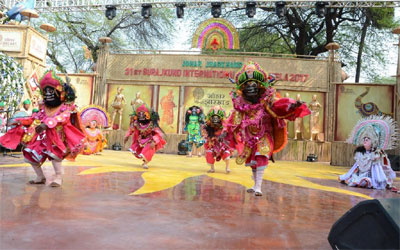 Surajkund, Faridabad, Haryana | February | 06, 2017 :: Nature and Culture of Jharkhand is unique. It’s unique culture is full of numerous elements of Music and Dances, without which Jharkhand is incomplete. When we talk about its cultural heritage, the first thing that comes on the list is ‘Chhau Dance’. It’s a unique form of masked dance, which is preserved by the royal family of the former state of Seraikela in Jharkhand. The dancers impersonate a God, Animal, Bird, Hunter, Rainbow, Night, or Flower. This dance is performed in three styles named after the location where they are performed, i.e.’ Mayurbhanj Chau’ of Odisha, ‘Purulia Chau’ of West Bengal and ‘Seraikela Chhau’ of Seraikela & Kharsawan District(Historically Odia Princely States) of Jharkhand.
Surajkund, Faridabad, Haryana | February | 06, 2017 :: Nature and Culture of Jharkhand is unique. It’s unique culture is full of numerous elements of Music and Dances, without which Jharkhand is incomplete. When we talk about its cultural heritage, the first thing that comes on the list is ‘Chhau Dance’. It’s a unique form of masked dance, which is preserved by the royal family of the former state of Seraikela in Jharkhand. The dancers impersonate a God, Animal, Bird, Hunter, Rainbow, Night, or Flower. This dance is performed in three styles named after the location where they are performed, i.e.’ Mayurbhanj Chau’ of Odisha, ‘Purulia Chau’ of West Bengal and ‘Seraikela Chhau’ of Seraikela & Kharsawan District(Historically Odia Princely States) of Jharkhand.
Seraikela is the ‘ Beckoning Heart’ for the connoisseurs of music and dance. Here lies the garrison of world famous ‘Chhau Dance’ . The soil of Seriakela is vibrant with the periodicity of chhau which surmised the imagination of the enchanted and enamoured art lovers of India and across the world. The history of Seraikella Chhau almost faded in the dim past. The ancient Seriakella State was founded during the 17th Century (1620-25).The Chhau was nurtured in different Akharas (Gharana) first – (I) Nuragarh Akhara (II) Rajendra Pattanayak Akhara or Amin Sahi Akhara. Chhau is a Vibrant, Vigorous dance form which originated in ancient times as a martial art form (Sword and Shield) – Phari Khanda (Phari means Sword & Shield means Khanda).
The Jharkhand pavilion has exhibited the art of mask making which is attracting a lot of crowd . Phalguni Sutradhar and Jagatsir Mistri are showcasing their rich talent in the mela by making beautiful masks made of paper and mud. Jagatsir Mistri also stated that there are about hundred families in the village who have more than five hundred artists practicing this art. Apart from the mask being used as a major prop for the dance form “Chhau”, it is also used as a Nazar bandi among the households of Jharkhand. The mask is usually sold in pairs and costs around INR 500 for each pair.
The visitors can enjoy Chhau dance at Jharkhand pavilion almost everyday. The team head of the troupe is Prabhat kumar Mahato who is taking care of their each and every need . Sitaram Mahato, one of the troupe members says that he has been doing this dance for almost 3 years. He also says that there are members who have been performing for almost 30 years. He belongs to the Choga Village of Seraikela District where the dance is being performed from generation to generation.
There is a depiction of both dance and martial practices along with mock warfare techniques called Khel, fancy demeanor of birds and animals called Chalis and Topkas . It is said that the Chau masks were introduced so that one could forget their real identity and get into the role they were portraying. Therefore ,the performance is purely based on their body movements. The dance is performed by male dancers, at night in an open space, called Akhada or Asar. The dance is rhythmic and set to traditional folk music, played on the reed pipes Mohuri and Shehnai. A variety of drums including the Dhol (a cylindrical drum), Dhumsa (a large kettle drum) and Kharka or Chad-Chadi are played along with music all at once . The themes for these dances include local legends, folklore and episodes from the Ramayana and Mahabharata and other abstract themes.
The Chhau dance has been nurtured under an atmosphere of independence, undisturbed by outside influence. It first shot into fame in the year 1938, when a dance troupe from Seraikela with great flutist Panna Lal Ghosh stormed into the cultural domain of Europe. The Seraikela Chhau artists are proud that the Chhau dance of Seraikela has been witnessed by all-time great-men, high dignitaries. The State Government Established Govt. Chhau Dance Centre in the year 1960 for the maintenance, preservation, propagation and the promotion of the Chhau heritage of Seraikela. Seraikela Chhau which was so far male parapet was thrown open it to female artists since 1995 in the Centre.
The Seraikella Chhau’s technique and repertoire were developed by the bygone nobility of this region who were both its performers and choreographers, and in the modern era people from all backgrounds perform. Seraikella Chhau , is one of the rarest cultural heritage of India, Preserved by the people of this area, through Centuries.
Jharkhand Pavilion had a distinguished visitor today—Padma Bhushan Sh. Rajeev Sethi. He is an eminent Indian designer, scenographer and art curator. He is the South Asia’s leading designer and is celebrated for his contribution to the art and cultural heritage. His work in design and architecture, performances and festivals, exhibitions and publication, policy and program, has brought contemporary relevance to traditional skills of vulnerable artisan communities and creative professionals. He is known to bring out the art forms of various craftsmen and artists and facilitating them to exhibit their talent on national as well as international platforms. Showcasing India as a culturally, historically, aesthetically and socially rich country, there are prestigious works which won him awards like Sanskriti award for the field of outstanding social and cultural achievement,1980, the first Indira Gandhi Lifetime Achievement Award for conservation by INTACH(Indian National Trust for Art and Cultural Heritage),2010, and many more.
Ranendra Kumar, Director (Sports), presented to Rajeev Sethi, as a token of thanks, a set of Madhubani painting ,


